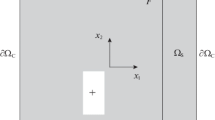Abstract
In a forward problem the system geometry, the governing equations, and the boundary and initial conditions are fully specified. The goal of solving such problem is to determine the dependent field variable, e.g., the temperature in a thermal problem and the stress or displacement field in a solid mechanics problem. In contrast, in an inverse problem either the system geometry, the governing equations, or the boundary and initial conditions are not fully specified, and the goal is to determine this unknown with the aid of some overspecified conditions. There are many such inverse problems which naturally arise in engineering and science. Surveys of inverse problem applications in heat transfer are given in [1,2], and applications to flaw detection and measuring residual stresses are found in [3–5].
Access this chapter
Tax calculation will be finalised at checkout
Purchases are for personal use only
Preview
Unable to display preview. Download preview PDF.
Similar content being viewed by others
References
Beck, J. V., Blackball, B. and St. Clair, Jr, C.R., Inverse Heat Conduction, Wiley Interscience Publication, New York, 1985.
Maldague, X., Non Destructive Evaluation of Materials by Infrared Thermography, Springer-Verlag, New York, 1992.
Kassab, A.J., Moslehy, F.A., and Daryapurkar, A., Nondestructive Detection of Cavities by an inverse Elastostatics Boundary Element Method, Engineering Analysis,Vol. 13, 1994, pp. 45–55.
Tanaka, M, Nakamura, M., Nakamo, T. and Ishikawa, H, Identification of Defects by the Elastodynamics Boundary Element Method Using Noisy Additional Information, Proc. 13th Int. Conf Bound Elem., Brebbia, C.A. and Gipson, G.S. (eds.), Computational Mechanics, New York, 1991 pp 799–810.
Zhang, F., Kassab, A.J., and Nicholson, D.W., Application of the Boundary Element Method to the Measurement of Residual Stress, Proc. 9th Int. Conf Bound. Elem. Tech., C.A. Brebbia and A.J. Kassab(eds.), Computational Mechanics, New York, 1994, pp. 165–171.
Kassab, AJ. and Hsieh, C.K., Application of Infrared Scanners and Inverse Heat Conduction Methods to Infrared Computerized Axial Tomography Rev Sci. Ins., Vol. 58,1987, pp. 89–95.
Kassab, AJ. and Pollard, J., Cubic Spline Anchored Grid Pattern Algorithm for High Resolution Detection of Subsurface Cavities by the IR-CAT Method Numerical Heat Transfer, Part B, Vol. 26, 1994, pp. 63–77.
Pollard, J. and Kassab, A.J., Automated Algorithm for the Nondestructive Detection of Subsurface Cavities by the IR-CAT Method, J. Nondes Eval., Vol.12, No.3, 1993, pp. 175–186.
Author information
Authors and Affiliations
Editor information
Editors and Affiliations
Rights and permissions
Copyright information
© 1995 Springer-Verlag Berlin Heidelberg
About this paper
Cite this paper
Kassab, A.J., Moslehy, F.A., Ulrich, T.W., Pollard, J. (1995). Inverse Boundary Element Solution for Locating Subsurface Cavities in Thermal and Elastostatic Problems. In: Atluri, S.N., Yagawa, G., Cruse, T. (eds) Computational Mechanics ’95. Springer, Berlin, Heidelberg. https://doi.org/10.1007/978-3-642-79654-8_499
Download citation
DOI: https://doi.org/10.1007/978-3-642-79654-8_499
Publisher Name: Springer, Berlin, Heidelberg
Print ISBN: 978-3-642-79656-2
Online ISBN: 978-3-642-79654-8
eBook Packages: Springer Book Archive




